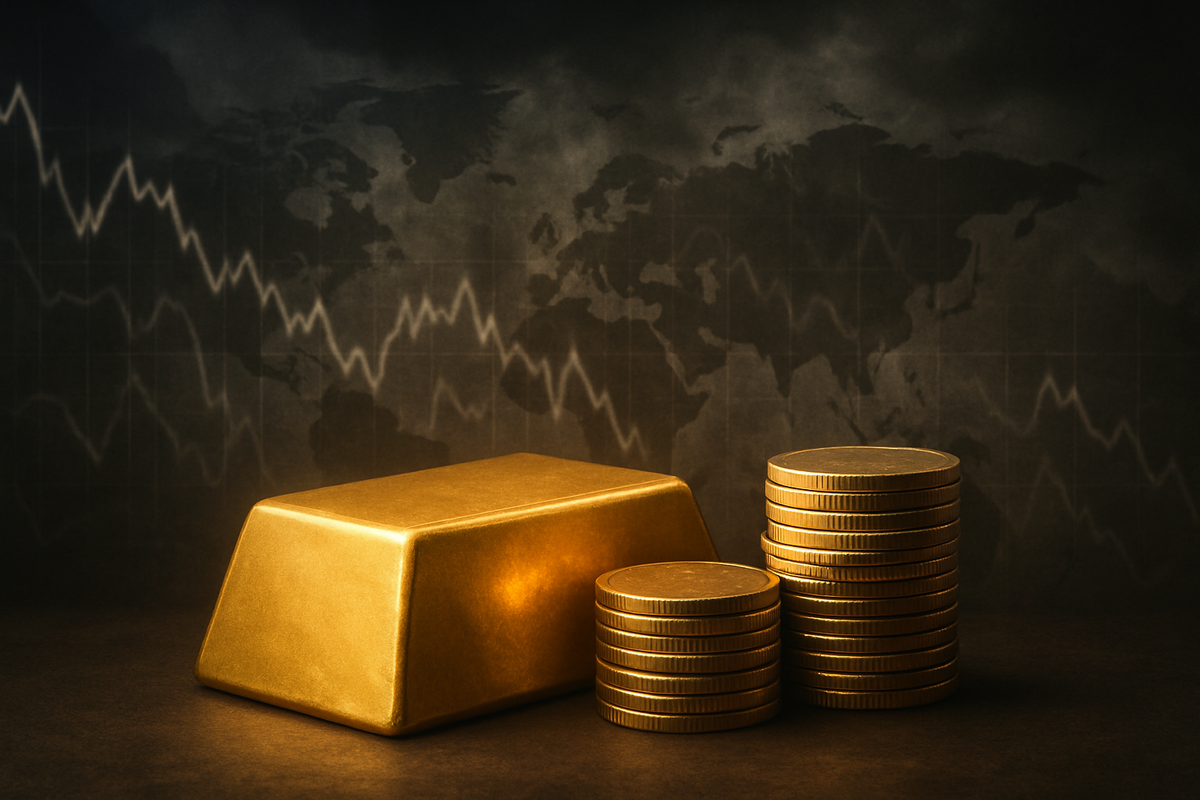Financial News
Gold's Unyielding Gleam: A Beacon in Turbulent Markets

As global financial markets navigate a landscape fraught with persistent inflation, shifting monetary policies, and escalating geopolitical tensions, gold has unequivocally cemented its position as a core defensive asset in investor portfolios. The precious metal, often dubbed the ultimate safe haven, has witnessed a remarkable surge, with spot gold prices hovering between an unprecedented $4,100 and $4,379.60 per ounce as of October 2025. This robust performance, reflecting year-to-date gains of 57% to 65%, underscores gold's enduring appeal as a bulwark against economic uncertainty and currency debasement. Its immediate implication is a noticeable reallocation of capital by investors seeking refuge from volatility and a reliable store of value.
The current economic climate, characterized by a complex interplay of macroeconomic forces, has created a fertile ground for gold's resurgence. Persistent and "sticky" global inflationary pressures, particularly in critical sectors like energy and groceries, continue to erode purchasing power. The U.S. Consumer Price Index (CPI) registered 4.2% in September 2025, significantly above the Federal Reserve's target, while other regions, such as the UK, project inflation averaging 3.4% in 2025. This sustained inflation directly fuels demand for gold as a proven hedge against rising prices. Simultaneously, a pivotal shift towards monetary policy easing by major central banks is making gold increasingly attractive. The U.S. Federal Reserve is widely expected to implement another 25 basis point rate cut in October 2025, with further reductions anticipated, in response to a softening labor market. Similar dovish pivots are being observed or considered by the European Central Bank (ECB) and other central banks globally, reducing the opportunity cost of holding non-yielding assets like gold.
Adding to this intricate mosaic are escalating and persistent geopolitical tensions. Renewed U.S.-China trade disputes, ongoing conflicts in the Middle East, renewed drone and missile attacks in Ukraine, and a prolonged U.S. government shutdown have collectively rattled investor confidence. These widespread geopolitical risks, coupled with broader policy uncertainty and international sanctions, drive investors towards gold as a premier safe haven. Central banks worldwide are also aggressively increasing their gold reserves, a strategic move motivated by geopolitical instability and a broader trend of de-dollarization, signaling a fundamental shift in global financial dynamics. This environment of heightened market volatility and a pervasive "risk-off" sentiment strongly supports gold's defensive role. A recent market stress test in October 2025 vividly demonstrated gold's effectiveness in providing portfolio protection, maintaining stability while equities and cryptocurrencies experienced significant declines. Concerns over credit stress within the U.S. regional banking sector and the private credit market further contribute to market jitters, pushing investors towards the perceived safety of gold.
Companies Navigating the Golden Tide: Winners and Losers
The ascendancy of gold as a core defensive asset creates distinct opportunities and challenges across various industries, particularly for public companies directly and indirectly exposed to the precious metal's market dynamics.
Gold Mining Companies (Winners): The most direct beneficiaries of surging gold prices are gold mining companies. Companies like Barrick Gold Corp. (NYSE: GOLD), Newmont Corporation (NYSE: NEM), and Agnico Eagle Mines Limited (NYSE: AEM) are poised for significant gains. Higher gold prices directly translate to increased revenue and potentially fatter profit margins, assuming production costs remain stable. These companies can leverage improved cash flows to fund exploration, expand existing operations, or return capital to shareholders through dividends and buybacks. Investors often flock to these equities as a leveraged play on gold, anticipating that their stock prices will appreciate at a faster rate than the underlying commodity. However, they also face operational risks, such as labor disputes, regulatory changes, and geological challenges, which can impact production and profitability.
Gold-Backed ETFs and Investment Vehicles (Winners): Exchange-Traded Funds (ETFs) that track gold prices, such as the SPDR Gold Shares (NYSEARCA: GLD) and iShares Gold Trust (NYSEARCA: IAU), have experienced record institutional inflows. These vehicles offer investors a convenient and liquid way to gain exposure to gold without the complexities of physical storage. Asset management firms that offer these products benefit from increased assets under management (AUM) and corresponding management fees. Similarly, companies providing gold-related investment services, refining, or storage solutions are likely to see increased demand for their offerings.
Companies Sensitive to Inflation (Mixed Impact/Potential Losers): While gold acts as an inflation hedge, companies that struggle to pass on increased costs to consumers may see their profit margins squeezed. Sectors heavily reliant on raw materials or energy, such as manufacturing or transportation, could face headwinds if they cannot effectively manage inflationary pressures. Conversely, companies with strong pricing power or those that benefit from inflation (e.g., certain real estate sectors) might be less affected. However, the broader inflationary environment, if not effectively managed, can lead to reduced consumer spending on discretionary goods, impacting retail and consumer discretionary companies.
Financial Institutions and Market Makers (Mixed Impact): Financial institutions involved in commodity trading, derivatives, and hedging services will likely see increased activity in gold markets. This can lead to higher trading volumes and fee income. However, extreme volatility can also pose risks, requiring robust risk management frameworks. Companies with significant exposure to traditional fixed-income assets, particularly those with long-duration bonds, might face challenges as rising inflation eradicates the real value of their holdings, though a dovish pivot by central banks could offer some relief. The broader "de-dollarization" trend, partially driven by central bank gold accumulation, could also subtly shift dynamics for global banks heavily invested in dollar-denominated assets.
The sustained bullish outlook for gold suggests that companies directly involved in the gold supply chain, from mining to investment products, are positioned to be significant winners. Meanwhile, companies in other sectors will need to carefully navigate the inflationary and volatile environment, with their success largely depending on their ability to adapt and maintain profitability amidst shifting economic tides.
The Broader Tapestry: Gold's Enduring Significance
Gold's reinforced position as a core defensive asset is not an isolated event but rather a critical thread woven into the broader tapestry of evolving global financial trends. This resurgence signifies a fundamental shift in investor psychology and macroeconomic realities, extending far beyond mere commodity trading.
Broader Industry Trends: Gold's current rally aligns with a growing sentiment of distrust in fiat currencies and a "great debasement trade." As central banks globally engage in strategic diversification away from the U.S. dollar, increasing their gold reserves at an unprecedented pace, it signals a deeper re-evaluation of reserve assets. This trend reflects a desire for greater financial autonomy and a hedge against the potential weaponization of currencies. The move also highlights a broader shift towards multi-polar financial systems, where the dominance of a single reserve currency is being challenged. Furthermore, the sustained demand for gold in a high-inflation, low-interest-rate environment underscores a return to fundamental principles of value preservation, contrasting with speculative frenzies seen in other asset classes.
Ripple Effects on Competitors and Partners: The strength of gold can have ripple effects on other traditional safe-haven assets. While gold shines, the appeal of certain government bonds, especially those with lower real yields, may diminish. The cryptocurrency market, often touted as "digital gold," faces renewed scrutiny regarding its true safe-haven capabilities, particularly during periods of intense market stress, as demonstrated by its declines during the October 2025 stress test. Gold's stability during such periods provides a stark contrast, potentially drawing capital away from more volatile digital assets. For partners in the financial ecosystem, such as asset managers and financial advisors, the heightened demand for gold necessitates a re-evaluation of portfolio construction strategies, emphasizing diversification and robust hedging mechanisms.
Regulatory and Policy Implications: The aggressive gold accumulation by central banks could influence international monetary policy and trade relations. A sustained de-dollarization trend, partially driven by gold, might lead to increased use of alternative currencies in international trade, potentially impacting the U.S. dollar's global liquidity and influence. Regulators might also pay closer attention to gold markets, particularly concerning transparency and market manipulation, given the increased capital flows. Furthermore, governments facing high debt levels and persistent inflation might view gold as a strategic national asset, potentially influencing domestic policies related to mining and exports.
Historical Precedents and Comparisons: Gold's current role echoes historical periods of economic instability and geopolitical turmoil. During the 1970s, gold surged dramatically amidst high inflation and oil crises, serving as a critical hedge against currency erosion. Similarly, during the 2008 financial crisis and the subsequent sovereign debt crises, gold demonstrated its counter-cyclical properties, acting as a flight-to-safety asset. The current environment, with its unique blend of inflation, geopolitical fragmentation, and central bank actions, presents a compelling parallel, reinforcing the historical narrative of gold as a reliable store of value when traditional financial systems face stress. This historical context provides a strong foundation for the current conviction that gold will retain its position as a core defensive asset.
What Lies Ahead: Navigating the Golden Path
The trajectory of gold in the coming months and years will be shaped by the persistence of current economic and geopolitical trends, offering both opportunities and challenges for investors.
Short-Term and Long-Term Possibilities: In the short term, analysts anticipate continued strength in gold prices, with some major banks forecasting gold to reach $4,400 per ounce by the end of 2025 and potentially $5,000 by mid-2026. This bullish outlook is underpinned by the ongoing "sticky" inflation, further anticipated rate cuts by central banks, and sustained geopolitical uncertainties. However, given that gold is currently in "overbought territory," short-term profit-taking or minor corrections are possible. Such pullbacks, if they occur, could be viewed as strategic buying opportunities by long-term investors. In the long term, gold's role as a fundamental hedge against systemic risks, currency debasement, and geopolitical instability is expected to solidify further, especially if the trend of central bank diversification continues and global economic fragmentation deepens.
Potential Strategic Pivots or Adaptations Required: Investors will need to adapt their portfolio strategies to account for gold's enhanced role. This may involve increasing strategic allocations to gold and gold-related assets, moving beyond tactical plays. Diversification within gold exposure, including physical gold, gold ETFs, and reputable gold mining equities, could be prudent. Financial advisors and asset managers may need to educate clients on gold's historical performance during periods of inflation and instability, re-emphasizing its role as a portfolio stabilizer rather than solely a growth asset. Companies, particularly those in the mining sector, might pivot towards optimizing production, managing costs, and exploring new reserves to capitalize on higher prices.
Market Opportunities or Challenges That May Emerge: The sustained demand for gold presents opportunities in related markets. Silver, often seen as "gold's poorer cousin," could experience a sympathetic rally, given its dual role as both a precious metal and an industrial commodity. Opportunities may also arise in specific gold-backed financial products, such as structured notes or derivatives, catering to sophisticated investors seeking leveraged exposure or tailored hedging solutions. However, challenges include the potential for increased regulatory scrutiny if gold markets become overly speculative, and the risk of price volatility if there are sudden shifts in central bank policy or a de-escalation of geopolitical tensions. The "crowding out" effect, where significant capital flows into gold, might divert funds from other asset classes, potentially impacting their performance.
Potential Scenarios and Outcomes: One key scenario is a continued "stagflationary" environment, where persistent inflation coexists with sluggish economic growth. In this scenario, gold would likely thrive, offering a critical safeguard for wealth. Another scenario involves a more aggressive de-dollarization push by major economies, leading to a further rebalancing of global reserves towards gold and other assets. Conversely, a rapid resolution of geopolitical conflicts and a swift return to central bank tightening (though less likely in the immediate future) could temper gold's ascent. However, the current confluence of factors suggests that gold's upward trajectory and defensive utility are likely to remain prominent, cementing its status as an indispensable component of resilient investment portfolios.
The Enduring Allure: A Comprehensive Wrap-Up
The recent performance and sustained demand for gold unequivocally underscore its enduring allure as a core defensive asset in the current turbulent financial landscape. As of October 2025, a potent combination of persistent global inflation, a decisive dovish pivot by major central banks, escalating geopolitical tensions, and elevated market volatility has converged to propel gold to unprecedented highs, reinforcing its role as a critical hedge against economic erosion and a reliable store of value.
Summary of Key Takeaways: Gold's robust performance is a direct response to macroeconomic uncertainties, serving as a tangible asset that preserves purchasing power when fiat currencies face inflationary pressures. The shift towards lower interest rates reduces the opportunity cost of holding non-yielding gold, while global instability drives a flight to safety. Central banks' aggressive accumulation of gold reserves further validates its strategic importance, signaling a broader re-evaluation of global financial architecture. This environment creates clear beneficiaries, primarily gold mining companies and gold-backed investment vehicles, while other sectors must adapt to inflationary pressures.
Assessment of the Market Moving Forward: The market is increasingly recognizing gold not just as a cyclical commodity, but as a foundational element of a diversified, resilient portfolio. Analysts anticipate continued strength in gold prices, projecting further gains into 2026. While short-term corrections are always a possibility, the fundamental drivers supporting gold's rally are deeply entrenched and unlikely to dissipate quickly. The ongoing de-dollarization trend and the search for stable assets in a volatile world are long-term structural tailwinds for gold.
Final Thoughts on Significance and Lasting Impact: Gold's resurgence is more than a fleeting market phenomenon; it reflects a profound shift in investor sentiment and global financial dynamics. It signifies a return to tangible value in an era of digital assets and complex financial instruments. The lasting impact will likely be a more prominent and permanent allocation of gold within institutional and retail portfolios, solidifying its role as an "asset for all occasions" capable of performing well during both risk-off and risk-on periods. Gold's unyielding gleam will continue to serve as a beacon of stability in an ever-changing financial world.
What Investors Should Watch For in Coming Months: Investors should closely monitor key economic indicators such as inflation rates, central bank interest rate decisions, and global geopolitical developments. Any significant de-escalation of conflicts or a sharper-than-expected decline in inflation could impact gold's trajectory. However, the current consensus points towards a sustained environment where gold's defensive characteristics will remain highly valued. Furthermore, tracking central bank gold purchases and institutional inflows into gold ETFs will provide insights into ongoing demand trends.
This content is intended for informational purposes only and is not financial advice
More News
View More




Recent Quotes
View More
Quotes delayed at least 20 minutes.
By accessing this page, you agree to the Privacy Policy and Terms Of Service.



